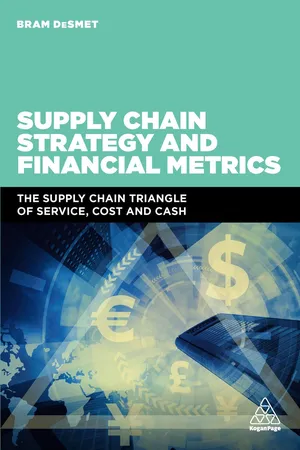
Supply Chain Strategy and Financial Metrics
The Supply Chain Triangle Of Service, Cost And Cash
- English
- ePUB (mobile friendly)
- Available on iOS & Android
Supply Chain Strategy and Financial Metrics
The Supply Chain Triangle Of Service, Cost And Cash
About this book
Supply Chain Strategy and Financial Metrics is a step-by-step guide to balancing the triangle of service, cost and cash which is the essence of supply chain management.
Supply chains have become increasingly strategy-driven, and this Supply Chain Triangle approach puts the supply chain at the heart of the strategy discussion instead of seeing it as a result.
Supply Chain Strategy and Financial Metrics fully reflects the 'inventory' or 'working capital' angle and examines the optimisation of the supply chain and Return on Capital Employed. Including case studies of Barco, Casio and a selection of food retail companies, this book covers building a strategy-driven KPI dashboard, target setting and financial benchmarking. Regular examples and diagrams illustrate how different types of strategies lead to different trade-offs in the Supply Chain Triangle. This ground-breaking text links supply chain, strategy and finance through financial metrics, therefore creating value for the shareholder. Online supporting resources include worksheets covering basic financial concepts such as cash flow and working capital, with example data sets and guidelines/exercises to make it interactive.
Frequently asked questions
- Essential is ideal for learners and professionals who enjoy exploring a wide range of subjects. Access the Essential Library with 800,000+ trusted titles and best-sellers across business, personal growth, and the humanities. Includes unlimited reading time and Standard Read Aloud voice.
- Complete: Perfect for advanced learners and researchers needing full, unrestricted access. Unlock 1.4M+ books across hundreds of subjects, including academic and specialized titles. The Complete Plan also includes advanced features like Premium Read Aloud and Research Assistant.
Please note we cannot support devices running on iOS 13 and Android 7 or earlier. Learn more about using the app.
Information
02
Strategy in the Supply Chain Triangle
Treacy and Wiersema’s three strategic options
Operational excellence
Table of contents
- Cover
- Title Page
- Copyright
- Contents
- List of figures
- List of tables
- About the author
- Foreword – Frank Vorrath, Johnson Controls
- Foreword – Johan Heyman, Barco
- Preface
- Acknowledgements
- Introduction
- 01 The Supply Chain Triangle of service, cost and cash
- 02 Strategy in the Supply Chain Triangle
- 03 Financial benchmarking in two dimensions
- 04 Financial target setting in two dimensions
- 05 The impact of strategy on financial benchmarking and target setting
- 06 Redefining the service corner as a value corner
- 07 Building a strategy-driven KPI dashboard
- 08 Implementing the strategy-driven supply chain
- Index
- Backcover